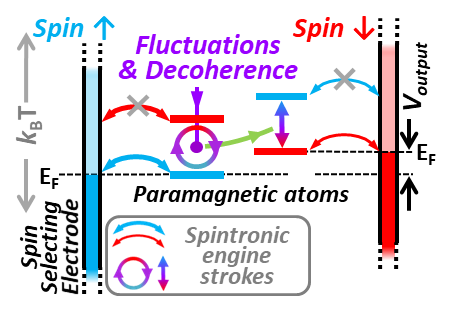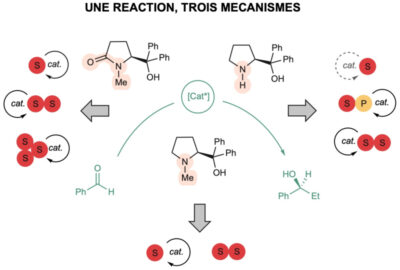Our modern, highly technological societies have developed within the paradigm of cheap, unlimited energy thanks to fossil fuel extraction. The resulting energy-driven human activity within the closed ecosystem that is Earth has caused multiple planetary boundaries to be exceeded. The wide-ranging impacts on our daily lives of the war-fueled and systemic, long-term energy crises have underscored our societal addiction to energy. Solving this conundrum will almost certainly require a systemic change in our society. This can occur through a combination of temperance, an astute use of existing energy solutions within planetary boundaries, and the development of radically new energy sources — if used wisely.

A multi-lab team of scientists, led by CNRS Senior Researcher Martin Bowen of the Institut de Physique et Chimie des Matériaux de Strasbourg (IPCMS), has experimentally demonstrated a new, industrially promising approach to harvest the most basic form of energy available: ambient heat. Heat is the energy wasted in any process that transforms energy from one type to another while generating work. Typical processes involve the cycles of an engine, e.g in cars, refrigerators, etc… The team’s nanoscale devices output around 10nW of dc electrical power at room temperature. The resulting power density is much greater than that using conventional thermoelectric approaches that convert heat gradients into electricity. And in this case, no heat gradient was applied nominally. To achieve this remarkable, counterintuitive result, which was published in the top-tier journal Advanced Materials, the team combined two heretofore non-interacting branches of physics. Quantum thermodynamics is a rapidly developing field that has recently begun reexamining how an engine operates when its components are reduced to excited electrons on single atoms. “At this scale, an engine’s efficiency can be increased by the quantum mechanical interactions between the engine parts. One boost can arise upon measuring the state of a quantum object that acts as the engine’s working substance”, explains Andrew Jordan, a leading quantum thermodynamics theoretician from Chapman University, CA USA.
Typically, these engine cycles are studied using well-controlled, model experiments in which an ensemble of atoms is excited using optical and microwave light. Achieving an electronic counterpart would open promising possibilities for industrialization. However, so far, semiconductor physics approaches have failed to generate a quantum advantage. “This is likely because these engines typically utilize electrons that mostly behave like classical, charged particles without strong quantum interactions,” explains Heiner Linke, a leading quantum engine experimentalist at Lund University in Sweden.
The Bowen team’s solution is to implement the electronic engine using spintronics, a green nanotechnology that exploits the electron’s quantum spin property in addition to its charge. The electron is a Fermion particle, meaning that its spin can exist in one of two possible states… when measured! Between measurements, it can exist in a superposition of these two states. In atomic magnets called paramagnets, this superposition arises from the energy of ambient heat. To harvest this heat, in the team’s design, engine-fueling quantum measurements on the atom-borne spin are performed by electronically connecting the atom to the outside world using electrodes that only allow electrons of one spin type to flow within a narrow energy window. “We believe that quantum measurements, together with other quantum forms of engine fuel, can account for our experimental results”, explains Martin Bowen.
Another quantum engine fuel has been predicted to arise when the spins forming the working substance experience quantum coupling between one another. “Using electron paramagnetic resonance, we discovered that the temperature at which this transition occurs in our chains of atomic magnets matches a change in the temperature dependence of the device’s output power”, adds teammate Bertrand Vileno of the University of Strasbourg.
To build these concept features into a nanoelectronic device, the Bowen team used molecules. Indeed, phthalocyanine molecules are not only quite commonplace, but can host magnetic atoms so as to form spin chains. Also, molecules can more easily be positioned within a vertical nanopillar device than by working with single atoms directly. In addition, over the past 10 years, the Bowen-led IPCMS team has extensively researched — and patented, the spin selective properties of the interface between molecules and simple ferromagnetic metals like iron (which is plentiful). “These latest results, with a 89% spin polarization of the current, showcase how competitive this so-called ‘spinterface’ is relative to other solutions for a spin-selecting device electrode”, comments IPCMS teammate Wolfgang Weber.
Spintronic technology is normally used to encode and transmit information at a low energy cost. “When in contact with a molecular spin chain, the spinterface can help to spintronically encode information onto the chain’s quantum excited state. To promote the thermal fluctuations on the 3-member chain that are to be harvested, it was necessary to weaken the magnetic coupling between them by intercalating monolayers of non-magnetic fullerenes,” explains IPCMS teammate Samy Boukari.
This highlights the need, when designing quantum spintronic engines, to exquisitely control the quality of the heterostructure stack used to make the device. “Spintronics is already present in hard disk drives and magnetic memories. This makes it a natural vector to industrialize quantum physics… if you can controllably insert quantum spin states within a device on an industrial scale”, adds Martin Bowen. At present, crafting vertical nanopillars that contain molecules remain an academic tour-de-force that only two labs worldwide master the technology for. Both are run by the Centre National de la Recherche Scientifique (CNRS), a French research agency. To transform entire, pristine heterostructures into nanoscale vertical devices without exposing the delicate molecular layer to degrading solvents, the IPCMS nanotechnological process utilizes several steps of macroscale and nanoscale masking. For co-author Armel Bahouka of the laser-cutting firm IREPA LASER near Strasbourg who provided the high-precision shadow-masks, “these results illustrate the potential that technological solutions have to help solve fundamental problems.”
A challenging but industrially promising alternative to molecules is to directly work with individual atoms. “Magnetic tunnel junctions comprising a magnesium oxide (MgO) barrier are found in hard drive read heads and magnetic memories. They constitute a prime industrialization vector for spintronic concepts”, reminds Shinji Yuasa, director of the Research Center for Emerging Computing Technologies at the Japanese National Institute of Advanced Industrial Science and Technology (AIST). The major hurdle is now to control the insertion of magnetic atoms into these devices. “Our 10-year collaboration with the IPCMS’s Bowen team has generated precious knowledge into how oxygen vacancies in the MgO barrier drive the device performance. Switching from an information technology to an energy technology use will require mastering how to fill these oxygen vacancies with appropriately placed magnetic atoms”, explains teammate Daniel Lacour of the Institut Jean Lamour in Nancy, France. The Bowen-led team had already reported first results into a more industrializable spintronic quantum engine using MgO magnetic tunnel junctions containing magnetic carbon atoms. What plagued those fortuitous results from 2019 was that energy output was observed on only one device.
The present study bolsters the case for other academic and industrial entities to further explore this new implementation of quantum energy technologies using spintronics. This could require accessing the properties of the spintronic quantum engine’s magnetic atoms while the engine is in operation. “This very challenging experiment is precisely what the Bowen team unsuccessfully set out to undertake, using their unique prior expertise on device in-operando characterization techniques at our synchrotron facility”, remarks co-author Philippe Ohresser of Synchrotron SOLEIL near Paris, France.
Looking ahead, the Bowen-led team plans to study both the molecular and the MgO approaches, thanks to research consortiums built using fresh funding from French agencies. “This second set of results presents us with the challenge of clarifying which resources are powering these quantum spintronic engines”, remarks project consortium member Robert Whitney, who develops quantum thermodynamical theory at the LPMMC at Grenoble. “Our plans to study the engine’s magnetic atoms while in operation using microwaves could be very insightful”, adds project consortium member Joris Van Slageren, who studies quantum magnetism at the Institute of Physical Chemistry in Stuttgart, Germany. For Martin Bowen, the results are the natural progression of his 20+ year career focus on how spin-polarized currents that run across spintronic devices interact with quantum states. “What’s new is that I now get to interact with a whole new scientific community, and research technological solutions to society’s energy-driven crises. But you’ll be seeing me at Scientist Rebellion protests too, because technology alone won’t avert the major planetary catastrophe in progress.”
Published paper:
“Quantum advantage in a molecular spintronic engine that harvests thermal fluctuation energy”
Advanced Materials
https://doi.org/10.1002/adma.202206688
email: bowen@unistra.fr



